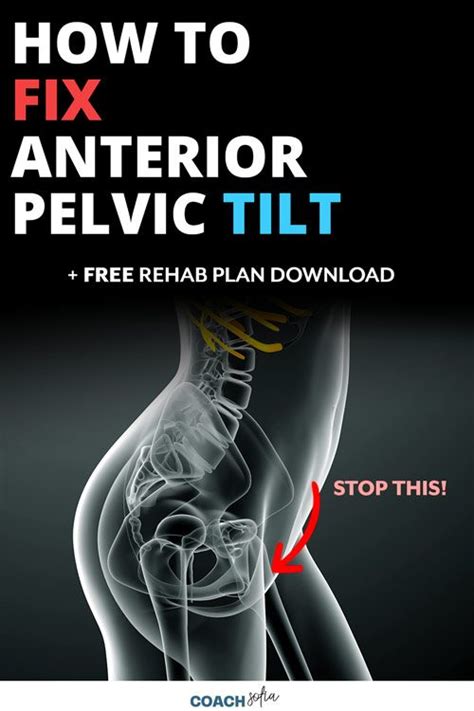How to Fix Anterior Pelvic Tilt: A Comprehensive Guide
Anterior pelvic tilt (APT) is a postural condition where your pelvis rotates forward, causing your lower back to arch excessively. This can lead to lower back pain, hip pain, and even restricted movement. Fortunately, with consistent effort, you can fix anterior pelvic tilt and improve your posture and overall well-being. This comprehensive guide will walk you through effective strategies.
Understanding Anterior Pelvic Tilt
Before diving into solutions, let's understand what causes APT. Several factors contribute, including:
- Weak Core Muscles: Weak abdominal muscles, particularly the transverse abdominis, and weak gluteal muscles (buttocks) fail to stabilize the pelvis, allowing it to tilt forward.
- Tight Hip Flexors: Tight hip flexor muscles pull the pelvis forward, exacerbating the tilt.
- Sedentary Lifestyle: Prolonged sitting weakens core muscles and tightens hip flexors.
- Improper Lifting Techniques: Incorrect lifting can strain the lower back and contribute to APT.
- Muscle Imbalances: Disproportionate strength between different muscle groups can throw your posture off balance.
Effective Strategies to Fix Anterior Pelvic Tilt
Fixing APT requires a multi-pronged approach targeting strengthening weak muscles and stretching tight ones.
1. Strengthening Exercises
Strong core muscles are crucial for pelvic stability. Focus on these exercises:
- Plank: A fundamental exercise for strengthening the entire core. Hold a plank position, maintaining a straight line from head to heels, for as long as you can comfortably maintain good form. Progress by increasing hold time.
- Bird-Dog: This exercise improves core stability and strengthens your back and glutes. Start on your hands and knees, extend one arm and the opposite leg simultaneously, maintaining a straight line from hand to foot.
- Dead Bug: Lie on your back with knees bent and arms extended. Slowly lower one arm and the opposite leg simultaneously, maintaining core engagement.
- Glute Bridges: Lie on your back with knees bent and feet flat on the floor. Lift your hips off the floor, squeezing your glutes at the top.
2. Stretching Exercises
Tight hip flexors need to be stretched regularly. Incorporate these stretches:
- Kneeling Hip Flexor Stretch: Kneel on one knee with the other leg bent at a 90-degree angle. Push your hips forward until you feel a stretch in the front of your hip.
- Pigeon Pose: A yoga pose that deeply stretches the hip flexors and glutes. Begin on your hands and knees, bring one knee forward behind your wrist, extending the other leg back.
- Lying Hip Flexor Stretch: Lie on your back with one leg straight and the other bent. Pull the straight leg towards your chest, feeling a stretch in the front of your hip.
- Hamstring and Quad Stretches: Don't forget these crucial muscle groups that often contribute to pelvic imbalances.
3. Lifestyle Modifications
Besides targeted exercises, making lifestyle changes can significantly improve your posture:
- Increase Physical Activity: Regular exercise, including cardio and strength training, strengthens your core and improves overall posture.
- Improve Your Sitting Posture: Avoid slouching. Maintain a neutral spine while sitting, ensuring your back is supported. Consider using a lumbar support cushion.
- Correct Lifting Techniques: Bend at your knees and hips, keeping your back straight when lifting heavy objects.
- Reduce Sitting Time: Take frequent breaks to stand up and move around.
4. Professional Guidance
Seeking professional guidance is beneficial, especially if you have persistent pain or severe APT.
- Physical Therapist: A physical therapist can assess your posture, identify contributing factors, and create a personalized exercise program.
- Chiropractor: A chiropractor can address spinal misalignments that may be contributing to APT.
Maintaining a Neutral Pelvis: Long-Term Strategies
Consistency is key to maintaining a neutral pelvic position. Regular exercise, stretching, and mindful posture awareness are essential for long-term success. Listen to your body, and don't hesitate to adjust your routine as needed. Remember, gradual progress is better than rapid, unsustainable change.
By consistently incorporating these strategies into your daily routine, you can effectively fix anterior pelvic tilt, improve your posture, and alleviate associated pain. Remember to consult with a healthcare professional for personalized advice.
